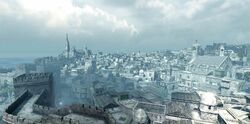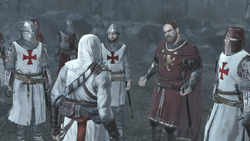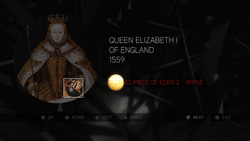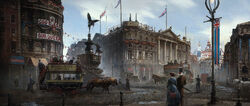The United Kingdom of Great Britain and Northern Ireland, often referred to simply as the United Kingdom or Britain, is a European sovereign state formed from the union of the Kingdoms of England and Scotland which includes the island of Great Britain, the northern part of Ireland, and many other small territories.
Before the United Kingdom was formed, Britain consisted of two sovereign states, the Kingdom of Scotland and the Kingdom of England, which united in 1707 to form the Kingdom of Great Britain. In 1801, Ireland was incorporated into the Kingdom of Great Britain to form the United Kingdom of Great Britain and Ireland. The city of London has been the capital of England—and its successor state—since the Norman conquest of 1066.
History
It is believed the story of King Arthur Pendragon has its basis in one of the Swords of Eden discovered during the Dark Ages, after the Roman Empire released its hold on England.[1]
Kingdom of England
Crusades
The Kingdom of England was governed by the Plantagenet dynasty during the Medieval era, of which Richard I was king during this time. He was noted as being one of the most powerful men in Europe and one of the most successful English kings of the Medieval period, as he ruled over England and half of France, where he was raised; his ferocity and fearlessness in battle gave him the nickname "Richard the Lionheart".[2]

Under his rule, England led the Crusades and quickly took control of Acre in June 1191. Soon after, Richard left Acre to move his armies south, leaving William of Montferrat in Acre as the city's regent. While William plotted with the Knights Templar to betray Richard, he was quickly dispatched by the Assassin Altaïr Ibn-La'Ahad.[2]
When the English arrived in Arsuf, Altaïr was accused of killing the leaders of the Knights Hospitalier, Garnier de Naplouse, and of the Knights Teutonic, Sibrand. Altaïr explained to Richard that the leaders planned to overthrow the king along with Robert de Sable, who dismissed the claim.[2]

Richard was unsure of who to believe, and so he placed the verdict in the hands of God through a trial of combat between Altaïr and Robert, the latter accompanied by his Templars. Inevitably, Altaïr succeeded the trial, so Richard accepted the Assassin's version of events, following which the pair discussed their philosophies and beliefs; Richard explained that he believed in peace at heart, but that it could only be achieved by destroying his enemies.[2]
First Barons' War
Richard was succeeded by his brother John, whose incompetent rule led to the composition of the Magna Carta in 1215. The treaty was imposed by disgruntled English baronage to curb limits on his power, but John refused to follow through despite signing the document, leading to the First Barons' War. The Assassin Robert Fitzwalter led the barons to depose John and replace him with Prince Louis VIII of France, but was opposed by his fellow Assassin William of Cassingham, who despised the French, seeing the barons' need for external allies as callous. The war ended with Louis being pushed out of England and William ensuring John's son Henry III's place on the English throne.[3]
Renaissance
Henry VII of the House of Tudor rules England with unflinching power. Though England enjoys peace and stability under his command, he may soon become a victim of Templar manipulation.An Assassin's observation, 1503.
During the mid-Renaissance era, London was ruled by King Henry VII, and the Templars Lambert Simnel and Perkin Warbeck made attempts to obtain the English throne for their Order. However, their plans were thwarted by King Henry, as he imprisoned Lambert, and had Perkin hanged.[4]
In 1503, Ezio Auditore da Firenze, Mentor of the Italian Assassins, sent a group of his recruits to London to aid King Henry, and eliminate any remaining power the Templars held in the country. After convincing him that they had similar interests, the Assassins were sent after Simnel and Warbeck's co-conspirator, Margaret of York, and in November of that year, they made sure she died a "natural death" by using a discreet poison.[4]

Soon after, the other conspirators fled to smaller villages, and began to rally the civilians there to rise up against their king. The Assassins _targeted only members of the Templar Order, and killed all but one. In exchange for his life, the Templar revealed that his Order had infiltrated King Henry's Star Chamber, the secret high court in the Palace of Westminster.[4]
The apprentices quickly began a search for the infiltrators, and eventually tracked down a group of Englishmen signing documents for the Templar-affiliated Borgia family. As a reward for eliminating them, King Henry offered the Assassins a seat in the Star Chamber.[4]
Elizabethan Era
I sit in my study, alone, staring at the painting Uncle John has given me. My hands tremble as my fingers brush the edge of the dry wax sealing his scroll.Elizabeth Jane Weston after receiving John Dee's gift.

On 19 July 1553, Mary I ascended the throne of England and Ireland following Henry VII's death. She wished to restore England to Roman Catholicism, and in the process, she had almost 300 religious dissenters burned at the stake. The Assassins monitored her for a while before they finally assassinated her on 17 November 1558 in favor of her Protestant half-sister, Elizabeth.[5]
With the death of Mary, Elizabeth I became one of the most notorious monarchs of England, reigning from 1558 until her death in 1603. She reverted the damage of Mary's reign and came into possession of an Apple of Eden which she secretly kept hidden in her globus cruciger.[5] Elizabeth's mathematician and consultant John Dee was aware that Elizabeth had possession of the Apple and how powerful it was.[6]

Following Elizabeth's death, Dee sent a wedding present of a painting of her wielding the artifact during the Judgement of Paris to his colleague Edward Kelley's stepdaughter, Elizabeth Jane Weston - an English poet. The painting contained Queen Elizabeth holding the Apple of Eden and three goddesses, who Weston believed were "Hera, Athena and Aphrodite".[6]
After noticing that the orb was similar to that of John Dee's golden orb, which he kept in his armoire, Elizabeth read the accompanying letter to the painting, which confirmed her suspicions, wherein John Dee stated he possessed a golden orb identical to that of Queen Elizabeth's and that the goddesses were real.[6]
Restoration era
I am invited to England to receive my crown. I must prepare for my return. There are many things I must do once I am there. Many wrongs I must right!Charles II, 1660.

In 1642, the English Civil War began between King Charles I and the forces of the English Parliament led by Oliver Cromwell. Charles eventually lost this war, and was beheaded on January 30 1649. His son, the future King Charles II, attempted to regain power, but lost the war at the Battle of Worcester and fled to France.[7]
During Charles' time in the Dutch Republic, Cromwell became Lord Protector, and was in charge of the country until Charles II was finally restored to the throne on 29 May 1660, with the help of General George Monck. At his coronation, Charles noticed a man holding a sphere wrapped in a thick piece of cloth, who conversed with his General.[7]
Great Britain
British Empire

The British Empire was utilized by the Templars as a way to exert their control over the New World. It was noted to have ruled over various parts of the Caribbean including Jamaica, the Bahamas, Barbados and the Cayman Islands. Throughout the 17th and 18th century, the region experienced a rise in piracy, so much so that three crucial periods each became known as a Golden Age of Piracy.[8]
This was epitomized by a number of conflicts such as the declaration of a pirate republic in Nassau, resulting in a bloody conflict and the re-establishment of British control in the Bahamas. During this time, Europe was entangled in the bloody War of the Spanish Succession and the city of Bristol grew as one of Britain's key naval ports. Men were employed as privateers for the Royal Navy from the surrounding counties in the south-west of England and Welsh valleys. Some privateers, such as Edward Kenway, later took up piracy.[8]
The city of Liverpool in the north of England grew into an industrious city during the 18th century. In 1744, Haytham Kenway came to the city to aid the Templars. He did so by performing his first assassination on a greedy merchant.[9] By the 1760s, the Grandpré business began to export and import goods to and from the city; Liverpool was the only city in Great Britain to which the Grandpré's conducted such trade operations.[10]
At this time, Britain ruled the Thirteen Colonies of North America. Following the costly French and Indian War, many British Americans grew disgruntled with taxation and lack of representation in Parliament. Following incidents such as the Boston Massacre and Boston Tea Party, the American Revolutionary War broke out and the colonies declared their independence. By 1783, the British Army lost the war and signed a peace treaty, which resulted in the independence of the United States of America and marked the end of the First British Empire.[11]
Victorian Era

During the Victorian period—marked by the reign of Queen Victoria as Britain's monarch—numerous inventions, discoveries and developments took place across the empire which subsequently saw Britain modernize at a momentous pace to become the largest empire in history. The most prominent discoveries and developments during the period included the expansion of the railway network; the development of new methods of communication (such as the telephone); electricity; sanitation reformations in inner cities such as London and a series of medical developments which lead to a drastic reduction in mortality rates across the British Empire.[12]
Throughout the early Victorian Era the Templar Order remained a dominant force across the British Empire and in the City of London, which served as a stronghold for the Order. Under the leadership of Crawford Starrick, the Order set out to actively encourage inequality and poverty across the city to provide them with order and power at the mercy of the wider population. At their height, the Templars embodied the bulk of London's bureaucratic organisations and controlled most aspects of life throughout the city, before being challenged by a crime syndicate orchestrated by twin assassins Jacob and Evie Frye, known as the 'Rooks'.[12]
In the late nineteenth century, the Hermetic Order of the Golden Dawn was founded in London, led by William Robert Woodman, William Wynn Westcott, and Samuel Liddell Mathers. The organization was closely tied to the occult, which was frowned upon by the society, and was therefore forced to stay secret. However, due to tensions and a struggle for power, the Order soon started to decline, until it eventually fell apart.[13]
Modern times
During World War I Jacob Frye's granddaughter Lydia protected London from German Templar machinations and tracked down and eliminated a group of spies headed by a sage. She worked alongside Winston Churchill in exchange for the enfranchisement of women to vote.[12]
The United Kingdom was involved in World War II, a Templar plot devised to create their New World Order. The Prime Minister at the time, Winston Churchill, was secretly a Templar puppet and worked with the man that was supposed to be his greatest enemy, Adolf Hitler, in order to orchestrate the transfer of a Piece of Eden.
The 20th century marked the decolonization of the British Empire, with the United Kingdom retaining sovereignty over a few former colonies today as Overseas Territories such as the Cayman Islands in the Caribbean.[8]
From 1979 to 1990, Margaret Thatcher held the position of Prime Minister of the United Kingdom, and she too was manipulated by the Templar shadow-company Abstergo Industries. During her term, she installed Boris Yeltsin, another Templar puppet, as Russia's new president.[14]
In October 2015, Abstergo Industries successfully retrieved the Shrouds of Eden artifact from a vault beneath Buckingham Palace after a fight with the Assassins resulting in the death of Inner Sanctum member Isabelle Ardant.[12]
In December 2016, after discovering Aguilar's Apple, Alan Rikkin called a meeting with the Council of Elders in London at the Grand Templar Hall. While presenting the Apple's abilities, Alan was assassinated by Callum Lynch who took the Apple and fled.[15]
In late-2018, Layla Hassan and her team were stationed in a loft apartment in London while searching the memories of the Spartan misthios Kassandra in order to locate more Isu artifacts before Abstergo could. Kiyoshi Takakura, a member of the team kept watch from outside. Eventually, the cell's location was identified by Abstergo and so they were forced to flee, though not before Layla left a USB drive at the apartment that could be remotely scan and infect secure computer systems, such as that held by the Head of Operations at Abstergo.[16]
References
- ↑ Assassin's Creed II – Glyphs
- ↑ 2.0 2.1 2.2 2.3 Assassin's Creed
- ↑ Assassin's Creed: Memories
- ↑ 4.0 4.1 4.2 4.3 Assassin's Creed: Project Legacy – Contracts
- ↑ 5.0 5.1 Assassin's Creed II
- ↑ 6.0 6.1 6.2 Assassin's Creed: Project Legacy - Divine Science: Chapter 3 - Elizabeth Jane Weston
- ↑ 7.0 7.1 Assassin's Creed: Project Legacy – Holidays: Chapter 1 - Ghosts of Christmas Past
- ↑ 8.0 8.1 8.2 Assassin's Creed IV: Black Flag
- ↑ Assassin's Creed: Forsaken
- ↑ Assassin's Creed III: Liberation
- ↑ Assassin's Creed III
- ↑ 12.0 12.1 12.2 12.3 Assassin's Creed: Syndicate
- ↑ Assassin's Creed: Project Legacy – Divine Science: Chapter 4 - Frater V.O.V.
- ↑ Assassin's Creed: Brotherhood – Rifts
- ↑ Assassin's Creed (film)
- ↑ Assassin's Creed: Odyssey - Modern day
| ||||||||||||||||||||||||||||||||||||||||
| |||||||||||||||||||||||||||||||||||||
| |||||||||||||||||||||||||
| ||||||||||||||||||||||||||||
| ||||||||||||||||||||||||||||||||||||||||||||||
| |||||||||||||||||||||||||||||||||||||||||||||||||||||||||
